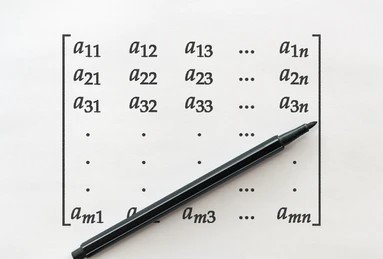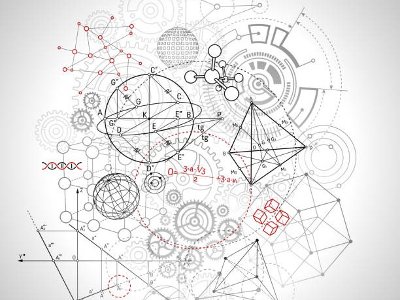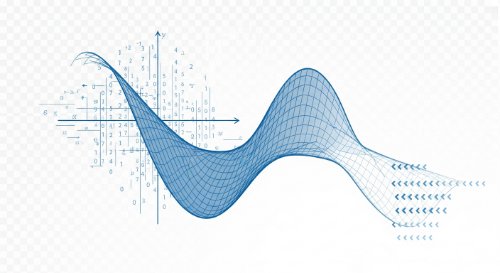Calculus of Scalar and Vector Fields (Undergraduate Advanced)
189
36 hrs
 MTH 202: Mathematical Methods IIComprehensive treatise of advanced mathematics covering vector calculus, complex numbers, linear vector spaces, linear maps, matrices, eigenvalues and eigenvectors.
Curated for second-year students of engineering and physical sciences at Obafemi Awolowo University, Ile-Ife, Nigeria. Students and professionals with similar learning goal will also find this learning track useful.
MTH 202: Mathematical Methods IIComprehensive treatise of advanced mathematics covering vector calculus, complex numbers, linear vector spaces, linear maps, matrices, eigenvalues and eigenvectors.
Curated for second-year students of engineering and physical sciences at Obafemi Awolowo University, Ile-Ife, Nigeria. Students and professionals with similar learning goal will also find this learning track useful.
Comprehensive treatise of advanced mathematics covering vector calculus, complex numbers, linear vector spaces, linear maps, matrices, eigenvalues and eigenvectors. Curated for second-year students of engineering and physical sciences at Obafemi Awolowo University, Ile-Ife, Nigeria. Students and professionals with similar learning goal will also find this learning track useful.
 CHE 305: Engineering Analysis IAdvanced engineering mathematics covering solid analytical geometry, integrals, scalar and vector fields, matrices and determinants and complex variables.
Curated for third-year students of engineering at Obafemi Awolowo University, Ile-Ife, Nigeria. Students and professionals with similar learning goal will also find this learning track useful.
CHE 305: Engineering Analysis IAdvanced engineering mathematics covering solid analytical geometry, integrals, scalar and vector fields, matrices and determinants and complex variables.
Curated for third-year students of engineering at Obafemi Awolowo University, Ile-Ife, Nigeria. Students and professionals with similar learning goal will also find this learning track useful.
Advanced engineering mathematics covering solid analytical geometry, integrals, scalar and vector fields, matrices and determinants and complex variables. Curated for third-year students of engineering at Obafemi Awolowo University, Ile-Ife, Nigeria. Students and professionals with similar learning goal will also find this learning track useful.
 GET 209: Engineering Mathematics IMaster the mathematical language of engineering. This programme delivers the complete analytical toolkit required for a successful engineering career, covering single-variable calculus, multivariable calculus, linear algebra, and vector analysis. It provides the essential foundation for all subsequent engineering courses.
This programme is for second-year undergraduate students across all engineering disciplines. It delivers the official NUC CCMAS curriculum for Engineering Mathematics, providing the core training required for advanced modules in mechanics, thermodynamics, and circuit theory.
Model and analyse complex physical systems using calculus, linear algebra, and vector analysis. You will be equipped to solve problems in dynamics, statics, and field theory, providing the quantitative proficiency required for advanced engineering study and professional practice.
GET 209: Engineering Mathematics IMaster the mathematical language of engineering. This programme delivers the complete analytical toolkit required for a successful engineering career, covering single-variable calculus, multivariable calculus, linear algebra, and vector analysis. It provides the essential foundation for all subsequent engineering courses.
This programme is for second-year undergraduate students across all engineering disciplines. It delivers the official NUC CCMAS curriculum for Engineering Mathematics, providing the core training required for advanced modules in mechanics, thermodynamics, and circuit theory.
Model and analyse complex physical systems using calculus, linear algebra, and vector analysis. You will be equipped to solve problems in dynamics, statics, and field theory, providing the quantitative proficiency required for advanced engineering study and professional practice.
Master the mathematical language of engineering. This programme delivers the complete analytical toolkit required for a successful engineering career, covering single-variable calculus, multivariable calculus, linear algebra, and vector analysis. It provides the essential foundation for all subsequent engineering courses. This programme is for second-year undergraduate students across all engineering disciplines. It delivers the official NUC CCMAS curriculum for Engineering Mathematics, providing the core training required for advanced modules in mechanics, thermodynamics, and circuit theory. Model and analyse complex physical systems using calculus, linear algebra, and vector analysis. You will be equipped to solve problems in dynamics, statics, and field theory, providing the quantitative proficiency required for advanced engineering study and professional practice.
Course Chapters
1. Introduction5
Meaning of scalars, vectors and tensors; Einstein's summation convention, Kronecker delta and Levi-Civita notations; orthogonal and orthonormal vector bases.
Chapter lessons
2. Scalar and Vector Products42
Scalar (dot) and vector (cross) products of vectors using sign functions.
Chapter lessons
2-1. Scalar products (1)17:50
2-3. Vector products (1)30:58
3. Scalar and Vector Fields3
4. Gradient of a Scalar Field54
Definition, evaluation and properties of the gradient of a scalar function.
Chapter lessons
4-2. Illustration38:33
4-3. Directional derivative43:55
4-4. Level curves and surfaces23:14
5. Divergence of a Vector Field43
Definition, evaluation and properties of the divergence of a vector field, and an introduction to the Laplacian of scalar and vector fields.
Chapter lessons
5-1. Definition10:12
Meaning of the divergence of a vector field and solenoidality.
5-2. Illustration13:37
Making sense of the divergence of a vector field.
5-3. Laplacian9:17
Meaning of the Laplacian of scalar and vector fields.
5-4. Properties19:19
Properties of the divergence of a vector field.
6. Curl of a Vector Field33
Definition, evaluation and properties of the curl (spin or rotor) of a vector field.
Chapter lessons
6-1. Definition10:12
Meaning of the curl of a vector field and irrotationality.
6-2. Illustration7:45
Making sense of the curl of a vector field.
6-3. Properties28:47
Properties of the curl of a vector field.
7. Use of Sign Functions13
Definitions and operations of gradient of a scalar field and divergence and curl of a vector field using sign functions and conventions such as the Einstein summation, Kronecker delta and Levi-Civita notations.
Chapter lessons
7-1. Definitions33:16
Defining the gradient, divergence, curl and Laplacian using sign conventions.
8. Orthogonal Curvilinear Coordinates (1)31
Definitions and illustrations of coordinates, coordinate lines and coordinate surfaces for the Cartesian coordinate system, general curvilinear coordinates, and general orthogonal curvilinear coordinates.
Chapter lessons
8-1. Cartesian coordinates43:50
Coordinate points, lines and surfaces on the Cartesian coordinate system.
8-2. Curvilinear coordinates56:19
Coordinate points, lines and surfaces on general curvilinear coordinates.
8-3. Orthogonal curvilinear coordinates31:24
Coordinate points, lines and surfaces on orthogonal curvilinear coordinates.
9. Orthogonal Curvilinear Coordinates (2)31
Meaning of right-handed coordinate systems, vector products of covariant base vectors in right-handed systems, length and volume elements in general orthogonal curvilinear coordinate systems.
Chapter lessons
9-1. Right-handed systems20:49
Meaning of right-handed systems, and the implication of right-handedness for vector products.
9-2. Arc length32:58
Arc length (length element) in orthogonal curvilinear coordinates.
9-3. Volume element57:40
Volume element (elemental volume) in orthogonal curvilinear coordinates and its relation to the Jacobian of transformation.
10. Orthogonal Curvilinear Coordinates (3)22
The gradient operator and contravariant bases vectors in general orthogonal curvilinear coordinates.
Chapter lessons
10-1. Gradient27:38
The gradient of a scalar in orthogonal curvilinear coordinates.
10-2. Base vectors35:41
Contravariant base vectors in orthogonal curvilinear coordinates, their relation to the covariant base vectors, and their vector product identities.
11. Orthogonal Curvilinear Coordinates (4)32
Divergence and curl operators in general orthogonal curvilinear coordinates.
Chapter lessons
11-1. Some identities33:49
Some vector product identities.
11-2. Divergence28:52
The divergence of a vector field in orthogonal curvilinear coordinates.
11-3. Curl49:34
The curl of a vector field in orthogonal curvilinear coordinates.
12. Orthogonal Curvilinear Coordinates (5)22
The Laplacian operator in general orthogonal curvilinear coordinates.
Chapter lessons
12-1. Laplacian (1)16:55
The Laplacian of a scalar field in orthogonal curvilinear coordinates.
12-2. Laplacian (2)10:22
The Laplacian of a vector field in orthogonal curvilinear coordinates.
13. Orthogonal Curvilinear Coordinates (6)2
Some special curvilinear coordinates - cylindrical and spherical coordinate systems.
Chapter lessons
13-1. Cylindrical coordinates30:22
Vector calculus properties in cylindrical coordinates.
13-2. Spherical coordinates33:34
Vector calculus properties in spherical coordinates.